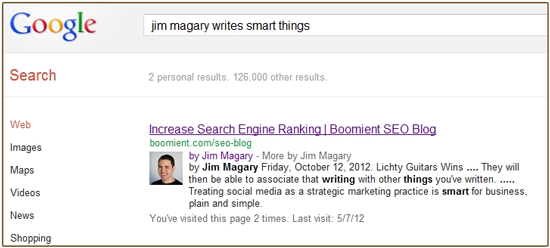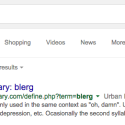 I watched a good video today from Matt Cutts and Othar Hansson from Google, explaining the advent of authorship markup. They hinted ever so slightly that this is something that Google will be using as a search engine ranking signal, and though it’s in the early stages, it’s something that HTML-savvy folks out there can implement easily on their sites.
I watched a good video today from Matt Cutts and Othar Hansson from Google, explaining the advent of authorship markup. They hinted ever so slightly that this is something that Google will be using as a search engine ranking signal, and though it’s in the early stages, it’s something that HTML-savvy folks out there can implement easily on their sites.
So what is it? Well at this point it refers to the authentication of authorship, and it’s implemented in HTML code by using an attribute called rel=”author”.
The idea behind rel=”author” is that this bit of code can be used on a page containing content written by you, to send a deliberate signal to search engines that a particular person wrote the content. This snippet is inserted into the HTML code of the link from that page that leads to your author profile page on the same site.
So if you write a blog post, use the rel=”author” attribute in a link back to your author profile page (again, only on the same site), so that Google will know that you wrote it and that you’d like to get credit for having written it if the page ever turns up in search results. They will then be able to associate that writing with other things you’ve written.
And Why Bother?
The promotional payoff, at least at the moment, is that if Google decides to trust this attribute, they will place your profile picture next to a search result that includes something you’ve written, although it’s not clear yet as to whether Google will assign this trust automatically. It looks something like this:

In the future, authorship markup may actually mean that Google begins to assign ranking value to your profile, and uses it to influence the ranking authority of an individual piece you’ve created. They won’t say how or how much, but the idea may be that authors can achieve a level of credibility on the web through these attributions, and that the sum total of your credited work will play a role in boosting the calculated relevancy of an individual piece, when compared to the work of other authors in the index.
If this is the case, the authorship markup function could serve as another social signal, similar to the strength of your influence as measured by re-Tweets, or re-shares of your posts, and other public signals which have been increased in importance and which Google and Bing admitted are now playing a role in rankings.
In the video, Matt and Othar suggest that the G-friendly thing to do is to also put another link on your own site back to your Google Plus profile, and make sure the profile also links back to the site where you created the content, creating a two-way verification process that Google can trust. That gives big G a reason to know that you are not trying to pretend to be Barack Obama or Maureen Dowd, since those folks would not link their Plus profile to your blog.
Here’s the basic format for a link with the rel=”author” attribute:
<a href=”https://boomient.com/jim-magary” rel=”author”>Jim Magary Author Page is here</a>
So to recap, the steps to authorship markup, for an individual blog site, as of August 2011:
- Link your Google Plus profile to the author profile on the site where you publish content (your blog, etc)
- Create a link on your site to your Google Plus profile page (ideally a link in the header, footer, or ubiquitous iconset so it’s on every page of the site)
- When you write a post or article, include a link to your own site’s author profile of you, and use the rel=”author” attribute in the link code as above.
Note to WordPress bloggers: Adding the link automatically to the author links that appear on blog posts can usually be accomplished by finding the single.php file and also the loop.php file, and editing the part where it calls for the info to build the author URL and post meta-data. Here’s what mine looked like after I added the markup:
<a href=”<?php echo get_author_posts_url( get_the_author_meta( ‘ID’ ) );?>” rel=”author”><?php the_author();?></a>
While we all love big ideas on the web, a daily reality is that it is the accumulation of dozens, if not hundreds, of small tactics like this one, that will pay dividends in the long run. If you’ve got the time and the knowledge, at least setup your two-way verification links so that Google may, just may, start looking at you as a real person (I know, it’s a lot to hope for).
OK
JM










